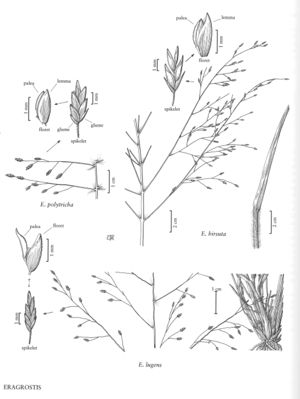Difference between revisions of "Eragrostis lugens"
FNA>Volume Importer |
FNA>Volume Importer |
||
| Line 17: | Line 17: | ||
-->{{Treatment/Body | -->{{Treatment/Body | ||
|distribution=Miss.;Tex.;La.;Fla.;Ala.;Tenn.;N.C.;S.C.;Ark.;Ga.;Mo.;Okla. | |distribution=Miss.;Tex.;La.;Fla.;Ala.;Tenn.;N.C.;S.C.;Ark.;Ga.;Mo.;Okla. | ||
| − | |discussion=<p | + | |discussion=<p>Eragrostis lugens grows on sandy dunes and along river banks, at 1-300 m. Its range extends from the southern United States to Peru and Argentina.</p> |
|tables= | |tables= | ||
|references= | |references= | ||
| Line 33: | Line 33: | ||
|basionyms= | |basionyms= | ||
|family=Poaceae | |family=Poaceae | ||
| + | |illustrator=Linda A. Vorobik and Cindy Roché | ||
|distribution=Miss.;Tex.;La.;Fla.;Ala.;Tenn.;N.C.;S.C.;Ark.;Ga.;Mo.;Okla. | |distribution=Miss.;Tex.;La.;Fla.;Ala.;Tenn.;N.C.;S.C.;Ark.;Ga.;Mo.;Okla. | ||
|reference=None | |reference=None | ||
| Line 38: | Line 39: | ||
|publication year= | |publication year= | ||
|special status= | |special status= | ||
| − | |source xml=https:// | + | |source xml=https://bibilujan@bitbucket.org/aafc-mbb/fna-data-curation.git/src/314eb390f968962f596ae85f506b4b3db8683b1b/coarse_grained_fna_xml/V25/V25_153.xml |
|subfamily=Poaceae subfam. Chloridoideae | |subfamily=Poaceae subfam. Chloridoideae | ||
|tribe=Poaceae tribe Cynodonteae | |tribe=Poaceae tribe Cynodonteae | ||
Revision as of 16:16, 30 October 2019
Plants perennial; cespitose, with innovations, without rhizomes, not glandular. Culms 30-70 cm, erect, sometimes geniculate, glabrous below the nodes. Sheaths usually mostly glabrous, summits hairy, hairs 2-5 mm, never papillose-based; ligules 0.2-0.3 mm; blades (4)8-22 cm long, 1-3.5 mm wide, involute to flat, both surfaces glabrous, margins sometimes with scattered hairs, hairs to 7 mm. Panicles 16-28 cm long, 10-21 cm wide, ovate, open; primary branches 0.6-15 cm, diverging up to 100° from the rachises, naked basally; pulvini hairy; pedicels 1.4-5(7) mm, diverging, wiry, present on all spikelets. Spikelets 2-4.5(5) mm long, 0.5-1(1.3) mm wide, narrowly lanceolate, plumbeous to reddish-purple, with 2-7 florets; disarticulation acropetal, paleas persistent. Glumes broadly ovate to narrowly lanceolate, hyaline, sometimes reddish-purple; lower glumes 0.6-1 mm; upper glumes 1.1-1.4 mm, usually broader than the lower glumes; lemmas 1.2-1.8 mm, broadly ovate, mostly membranous but the distal margins hyaline, lateral veins inconspicuous, apices acute; paleas 1.1-1.7 mm, membranous to hyaline, apices obtuse; anthers 3, 0.2-0.7 mm, reddish-purple. Caryopses 0.5-0.6 mm, obovoid to somewhat prism-shaped, terete to somewhat laterally compressed, sometimes with a weak adaxial groove, finely striate, usually opaque, faintly reddish-brown to whitish. 2n = 40, 80, ca. 108.
Distribution
Miss., Tex., La., Fla., Ala., Tenn., N.C., S.C., Ark., Ga., Mo., Okla.
Discussion
Eragrostis lugens grows on sandy dunes and along river banks, at 1-300 m. Its range extends from the southern United States to Peru and Argentina.
Selected References
None.
